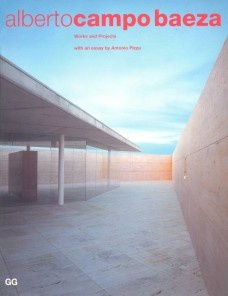Alberto Campo Baeza
Alberto Campo Baeza
Works and projects
Antonio Pizza (Org.)
Gustavo Gili, Barcelona; 1ª edição, 1999
original title: Alberto Campo Baeza
translator: Paul Hammond; Stephen Thorne
With an essay by Antonio Pizza
edition: english
paperback
174 p
22 x 28 x 1,5 cm
1100 g
illustrated
fullcolor
photos
drawings
ISBN
978-84-252-1781-4
(, )

about the book
In his introductory essay to this survey of Alberto Campo Baeza's projects and finished buildings, Antonio Pizza begins by listing the influences on the Spanish architect's career since 1971, the year in which he graduated from the Escuela de Arquitectura de Madrid. In particular, Pizza rightly draws attention to the importance of what Campo Baeza learned from Alejandro de la Sota, one of the most gifted of Spain's postwar architects. Campo Baeza's most characteristic architecture preserves features of de la Sota's severely rational compositional style, though the influences on his work are not just Spanish. They also include Jorn Utzon, Tadao Ando and other internationally famous architects (Antonio Pizza gives a full list in his introductory essay). Moreover, Campo Baeza's poetics is the outcome of a complex and wide-ranging dialogue with architectural history that has provided him not so much with a set of formal models as with a repertoire of compositional strategies, raising questions of method which he has answered by inverting Mies van der Rohe's celebrated dictum "less is more" to give "más con menos", more with less. The fact that achieving "more with less" is Campo Baeza's ultimate aim, and that variation rather than variety is one of the fundamental and most characteristic "techniques" he employs in his architecture, only goes to show how superficial the efforts of critics have been in attempting to reduce the tectonic austerity and luminarist poetry of his buildings to just another form of minimalism. Campo Baeza's simplified assemblies of primary geometric forms carry the rejection of decoration to disconcerting, almost hermetic extremes. Eliminating the superfluous and doing everything possible to communicate what remains by means of essentiality a more conceptual notion than minimalism in that it suggests simplification and purification, an expression of essence is both the primary aim and the message of Campo Baeza's architecture. The pure, dazzling whiteness to which his buildings and interiors aspire, and in many cases attain, is only the most obvious of the effects Campo Baeza is striving to achieve. What the architecture surveyed in this book conveys more than anything is a sense of timelessness and other worldliness. Through his ability to reject the secondary features of what constitutes the essential fascination of the modern, Campo Baeza shows us that the present is essentially an inhospitable and uninhabitable place. It is this existential insight that achieves architectural form in his buildings.
about the author
Antonio Pizza
Teaches History of Art and Architecture at the Escola Técnica Superior d’Architectura in Barcelona. He writes for several international magazines.


